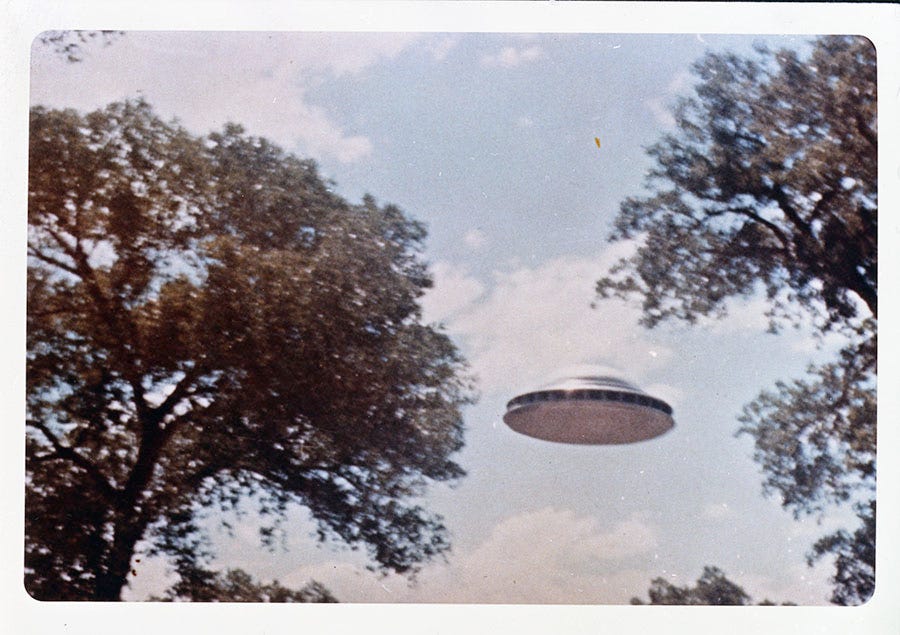TITAA #63.5: Deep Data on UFOs
Video Gen - Splicer2 - Archaeolinguistics - Deep Researchers - AI Ethics & Aha
TOC (links on the web page):
UFO Data, AI & Weird (above paywall)
Esoteric & Weird (Art, Archaeology, Science, AI Weird/Worrying)
Data Science & Vis (Deep Research, agents tools)
UFO Data, AI & Weird
In our sad period of US public data deletion, it seems trivial to feature this particular topic, but it is my mid-month weird news edition. Jon Keegan’s wonderful Beautiful Public Data newsletter featured UFO data and US government UFO history in a fine post last week. Covering the history of recent government decisions regarding study and transparency (a word that hurts right now), he cites the “Preliminary Assessment: Unidentified Aerial Phenomena” 2021 report:
The analysis examined 144 UAP reports gathered between 2004 and 2021 which originated from US government agencies. The report found that 18 of the incidents “appear to demonstrate advanced technology,” which it could not give an explanation for.
This was followed by NASA’s 2023 report, titled “NASA Unidentified Anomalous Phenomena Independent Study.” One conclusion: “Despite numerous accounts and visuals, the absence of consistent, detailed, and curated observations means we do not presently have the body of data needed to make definitive, scientific conclusions about UAP.” The work of collecting useful reports in order to better analyze the phenomena is ongoing, with the National Archives exposing their data in collections as well.
The government “ALL-DOMAIN ANOMALY RESOLUTION OFFICE” (lol; AARO) has published 3 annual reports of all sightings filed (check their site here for videos etc), and Jon made some Datawrapper plots of the latest report. Of the 757 reports filed, 21 are still undergoing analysis.
What’s the role of AI or good old machine learning in helping to look for and classify UFO/UAP phenomena? We’ve had SETI, the search for extraterrestrial intelligence, scanning the sky algorithmically for a long time. There’s a new one from George Tech called Gremlin, that Jon cites. Gremlin will create deployable sensor bundles to help get better quality data.
And now Avi Loeb’s Harvard-based Galileo Project: “The goal of the Galileo Project is to bring the search for extraterrestrial technological signatures of Extraterrestrial Technological Civilizations (ETCs) from accidental or anecdotal observations and legends to the mainstream of transparent, validated and systematic scientific research.” They have a 2025 report on “Commissioning An All-Sky Infrared Camera Array for Detection Of Airborne Objects.” Loeb suggests that UFOs may in fact be AI themselves, machines doing surveillance (source).
There’s also newbie Sky360, a citizen-science project to collect better data outside the government filter. They seem like a tech-oriented version of MUFON? Vice reports, it “aims to blanket the earth in affordable monitoring stations to watch the skies 24/7, and even plans to use AI and machine learning to spot anomalous behavior. …. The Sky360 stations consist of an AllSkyCam with a wide angle fish-eye lens and a pan-tilt-focus camera, with the fish-eye camera registering all movement. … There are a combination of AI models under the hood, and the system is built using the open-source TensorFlow machine learning platform so it can be deployed on almost any computer.” There’s a code repo and a Discord (obvi 😄).
A side-note on the weirder components at work here… I was entertained by the difference in expansions online for “UAP,” finding both “unexplained aerial phenomena” and “unexplained anomalous phenomena.” The latter is obviously much broader, covering all kinds of paranormal and other exotic behaviors. Indeed, linking aerial and UFO phenom to other kinds of extranormal would be in keeping with a lot of researchers’ approaches; we can wave at the old government Advanced Aerospace Weapon System Applications Program (AAWSAP)’s research on Utah’s “Skinwalker Ranch,” a site known for UFOs but also cattle mutilations, shadowy figures, weird lights, and other odd events going back to native American days (see e.g., one of many sources).
Phil Ford, co-host of my fav podcast Weird Studies, just had an entertaining article in the North American Review (fall 2024), “The View From the Cheap Seats at the UFO Show.” He shared with Patreon supporters.
To simplify a little, we might propose two basic types of non-human intelligence: extraterrestrial and ultraterrestrial. Extraterrestrial intelligence means beings from other locations within the physical space of the universe, i.e., other planets and star systems, who travel here by means of spacecraft, which we call UFOs. Most people assume that UFOs necessarily mean aliens. But the most important scientific researcher of UAP, Jacques Vallée, does not: he persuasively argues for ultraterrestrial intelligence, which belongs to daimons from imaginal and non-material planes of existence—fairies, elementals, goblins, angels, and all their varied company.
He goes on to discuss how hard it is to study something that doesn’t want to be studied. There is obviously a lot more to say about that and this topic, but this is a really long edition as usual. I suggest that you share some financial love for the Internet Archive, who are working on preserving that lovely government transparency data, which might be removed from those websites at any point. UFOs probably won’t make the spending gut (not a typo).
If you aren’t a subscriber, the mid-month news section features weirder news stories along with the last two weeks of tech news; and this issue has also a ton of video generation improvements, the new ArtBreeder app which I love, some stuff on Deep Research models (including links to Deep Research reports I made for this), and archaeo-linguistic mysteries, among many other tidbits.





